Comments / Questions (29)
![]() Lena Almkvist Olsson wrote:
Lena Almkvist Olsson wrote:
Hej Står i beskrivningen att alla varv stickas räta. Menas att det är rätstickning eller Innebär detta att vartannat varv blir avigt sett från framsidan. Med vänlig hälsning, Lena
07.06.2025 - 09:13DROPS Design answered:
Hej Lena. I förklaringen för rätstickning står det att alla varv stickas räta om du stickar fram och tillbaka (sett från rätsidan blir då vartannat varv rät och vartannat avigt). Läs sedan i beskrivningen när du ska sticka rätstickning och när du stickar på annat sätt. Mvh DROPS Design
09.06.2025 - 12:16
![]() DI MORRIS wrote:
DI MORRIS wrote:
Thanks for the quick response. This is the video I watched. It showed me clearly how "Pepita" works (I have never done this before) but it doesn't answer the question of why the pattern changes after every 4 rows.
12.08.2024 - 15:39
![]() DI MORRIS wrote:
DI MORRIS wrote:
I was really pleased to find the Pepita instructions but cannot work out why the pattern changes after 4 rows - it just seems to be the same thing
12.08.2024 - 15:25DROPS Design answered:
Dear Mrs Di Morris, maybe this video can help you to understand how to work the diagram for this pattern. Happy knitting!
12.08.2024 - 15:32
![]() Paula wrote:
Paula wrote:
Buongiorno, non sono sicura di aver capito la spiegazione del diagramma. Le prime 4 righe sono da lavorare con il colore blush e le altre 4 righe con il colore grigio scuro? Sono un pochettino confusa con le spiegazioni. Grazie mille
14.01.2024 - 14:02DROPS Design answered:
Buongiorno Paula, si è corretta la sequenza di colori. Buon lavoro!
02.03.2024 - 11:47
![]() Maria Elena Fancello wrote:
Maria Elena Fancello wrote:
Grazie mille per la risposta
10.01.2024 - 23:32
![]() Maria Elena Fancello wrote:
Maria Elena Fancello wrote:
Salve. Grazie di cuore per l'enorme e prezioso servizio che offrite. Avrei un dubbio sicuramente dovuto alla mia esperienza limitata. Nelle istruzioni relative ai gilet leggo sempre che dopo il bordo a coste è necessario diminuire il numero delle maglie. Come mai? In tal modo non si restringe il modello proprio quando dovrebbe essere più ampio per seguire la linea del corpo? Grazie per l'attenzione. Sicuramente da esperti quali siete mi consentirete di apprendere qualcosa di più.
05.01.2024 - 12:18DROPS Design answered:
Buonasera Maria Elena, il bordo a coste tende a "tirare" il lavoro, questo è il motivo per cui si avviano più maglie e poi si diminuiscono alla fine del bordo per impedire al lavoro di contrarsi. Buon lavoro!
10.01.2024 - 16:40
![]() Maria Elena Fancello wrote:
Maria Elena Fancello wrote:
Salve. Grazie di cuore per l\'enorme e prezioso servizio che offrite. Qvrei un dubbio sicuramente dovuto alla mmia esperienza limitata. Nelle ustruzioni relative ai gilet leggo sempre che dopo il bordo a coste è necessario diminuire il numero delle maglie. Come mai? In tal modo non si restringe il modello proprio quando dovrebbe essere più ampio per seguire la linea del corpo? Grazie per l\'attenzione. Sicuramente da esperti quali siete mi consentirete di apprendere qualcosa dipiù.
05.01.2024 - 11:56DROPS Design answered:
Buonasera Maria Elena, il bordo a coste tende a "tirare" il lavoro, questo è il motivo per cui si avviano più maglie e poi si diminuiscono alla fine del bordo per impedire al lavoro di contrarsi. Buon lavoro!
10.01.2024 - 16:35
![]() Jacqueline wrote:
Jacqueline wrote:
Waarom moet je voor-en achterpand op een rondbreinaald breien. Voor de hals en mouwen snap ik. alvast bedankt, Jacqueline
25.02.2022 - 14:44DROPS Design answered:
Dag Jacqueline,
Dit is vanwege het grote aantal steken dat je op de naald hebt (met name bij de grotere maten). Bij rechte naalden past dat niet.
26.02.2022 - 15:38
![]() Any De Lezel Couture , Marie Darchy wrote:
Any De Lezel Couture , Marie Darchy wrote:
Bonjour, je voulais savoir si je pouvais remplacer le point fantaisie par du jersey. Je vous remercie pour votre réponse.
10.02.2022 - 09:19DROPS Design answered:
Bonjour Mme Darchy, il serait alors peut-être plus simple de consulter nos pulls sans manches certains d'entre eux sont en jersey, vous y trouverez fort probablement votre bonheur. Bon tricot!
10.02.2022 - 09:30
![]() Ruth wrote:
Ruth wrote:
Stemmer det at mønsteret ikke blir likt i sidene? Ikke like langt til «løs» maske. Midt på vesten vil ikke være midt mellom to «løse» masker. Var dette forståelig?
26.10.2021 - 23:51DROPS Design answered:
Hej Ruth, det kan stemme, men du skal sy siderne sammen indenfor en maske, så det kommer du ikke til at se. God fornøjelse!
28.10.2021 - 13:32
Back to School#backtoschoolvest |
|||||||||||||
 |
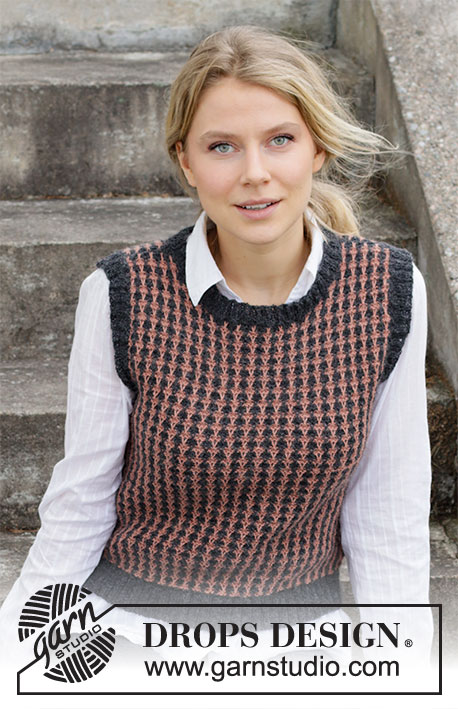 |
||||||||||||
Knitted vest / slipover with Pepita pattern in DROPS Alpaca. Sizes S - XXXL.
DROPS 218-22 |
|||||||||||||
|
------------------------------------------------------- EXPLANATIONS FOR THE PATTERN: ------------------------------------------------------- RIDGE/GARTER STITCH (worked back and forth): Knit all rows. 1 ridge in height = Knit 2 rows. PATTERN: See diagrams A.1, A.2 and A.3. The diagrams show all rows in the pattern from the right side. DECREASE TIP (evenly spaced): To work out how to decrease evenly, count the total number of stitches on needle (e.g. 118 stitches) and divide by number of decreases to be made (e.g. 20) = 5.9. In this example decrease by knitting approx. each 5th and 6th stitch together. INCREASE TIP (for sides of body): Increase 1 stitch inside 1 edge stitch by making 1 yarn over; on the next row work the yarn over twisted to avoid a hole. The increased stitches are worked into the pattern as you go. KNITTING TIP: When increasing in the side the pattern continues upwards as before, the same applies when decreasing for the armholes and neck. If the outermost stitch in the sides or neck is a stitch which should be slipped, replace it with a knitted stitch in the colour the row is being worked in. ------------------------------------------------------- START THE PIECE HERE: ------------------------------------------------------- VEST – SHORT OVERVIEW OF THE PIECE: The back and front pieces are worked back and forth separately, bottom up. The shoulders and sides are sewn, then the neck and sleeve edges are worked in the round to finish. BACK PIECE: Cast on 118-130-142-154-170-186 stitches with circular needle size 3 mm and dark grey. Knit 1 row from the right side. Then work rib starting from the wrong side as follows: 1 edge stitch in GARTER STITCH, knit 1, * purl 2, knit 2 *, work from *-* until there are 4 stitches left, purl 2, knit 1 and 1 edge stitch in garter stitch. Continue with knit over knit, purl over purl and garter stitch over garter stitch until the rib measures 5 cm in all sizes. Change to circular needle size 3.5 mm, knit 1 row from the right side and decrease 20-24-28-28-28-32 stitches evenly spaced – read DECREASE TIP in the explanations above = 98-106-114-126-142-154 stitches. Knit 1 row from the wrong side. Now continue according to diagrams A.1, A.2 and A.3 as follows from the right side: Work A.1, then work A.2 until there is 1 stitch left on the row and finally A.3. Continue this pattern until the piece measures approx. 8 cm from the cast-on edge in all sizes. REMEMBER THE KNITTING TENSION! Read KNITTING TIP and INCREASE TIP in explanations above! On the next row increase 1 stitch on each side by working 2 stitches in both of the outermost stitches (the increased stitches are worked into the pattern). Repeat the increase every 9-9½-10-10½-11-11½ cm a total of 3 times in all sizes = 104-112-120-132-148-160 stitches. Continue the pattern until the piece measures 30-31-32-33-34-35 cm from the cast-on edge. Cast off 5-6-7-9-11-14 stitches on each side for the armholes, then cast off 1 stitch at the beginning of each row a total of 4-4-5-7-10-11 times = 86-92-96-100-106-110 stitches. Continue the pattern until the piece measures 50-52-54-56-58-60 cm from the cast-on edge, then on the next row from the right side work as follows: Work the first 22-24-26-27-29-31 stitches as before (= right shoulder), and place these stitches on a thread. Cast off the next 42-44-44-46-48-48 stitches for the neck, work the last 22-24-26-27-29-31 stitches as before. Each shoulder is finished separately. LEFT SHOULDER (back piece): Start from the wrong side and cast off 1 stitch at the beginning of the next row from the right side = 21-23-25-26-28-30 stitches. Work until the piece measures 52-54-56-58-60-62 cm from the cast-on edge, cast off with knit in the same colour as the previous row. Cut and fasten the strands. RIGHT SHOULDER (back piece): Place the 22-24-26-27-29-31 stitches from the threadback on circular needle size 3.5 mm. The first rowis worked from the wrong side and cast off 1 stitch at the beginning of thefirst row = 21-23-25-26-28-30 stitches. Work until the piece measures 52-54-56-58-60-62cm from the cast-on edge (making sure the two shoulders match), cast off with knit in the same colour as the previousrow. Cutand fasten the strands. FRONT PIECE: Cast on 118-130-142-154-170-186 stitches with circular needle size 3 mm and dark grey. Knit 1 row from the right side. Then work rib starting from the wrong side as follows: 1 edge stitch in garter stitch, knit 1, * purl 2, knit 2 *, work from *-* until there are 4 stitches left, purl 2, knit 1 and 1 edge stitch in garter stitch. Continue with knit over knit, purl over purl and garter stitch over garter stitch until the rib measures 5 cm in all sizes. Change to circular needle size 3.5 mm, knit 1 row from the right side and decrease 20-24-28-28-28-32 stitches evenly spaced = 98-106-114-126-142-154 stitches. Knit 1 row from the wrong side. Now continue according to diagrams A.1, A.2 and A.3 as follows from the right side: Work A.1, then work A.2 until there is 1 stitch left on the row and finally A.3. Continue this pattern until the piece measures approx. 8 cm from the cast-on edge in all sizes. On the next row increase 1 stitch on each side by working 2 stitches in both of the outermost stitches (the increased stitches are worked into the pattern). Repeat the increase every 9-9½-10-10½-11-11½ cm a total of 3 times in all sizes = 104-112-120-132-148-160 stitches. Continue the pattern until the piece measures 30-31-32-33-34-35 cm from the cast-on edge. Cast off 5-6-7-9-11-14 stitches on each side for the armholes, then cast off 1 stitch at the beginning of each row a total of 4-4-5-7-10-11 times = 86-92-96-100-106-110 stitches. Continue the pattern until the piece measures 42-44-45-47-48-50 cm from the cast-on edge, then on the next row from the right side work as follows: Work the first 30-33-34-36-38-40 stitches as before (= left shoulder) and place these stitches on a thread. Cast off the next 26-26-28-28-30-30 stitches for the neck and work the last 30-33-34-36-38-40 stitches as before (= right shoulder). Each shoulder is finished separately. RIGHT SHOULDER (front piece): = 30-33-34-36-38-40 stitches. Continue with the pattern (the first row is from the wrong side) and cast off for the neck at the beginning of each row from the right side: 3 stitches 1 time, 2 stitches 1-2-2-2-2-2 times and 1 stitch 4-3-2-3-3-3 times = 21-23-25-26-28-30 stitches. Continue the pattern until the piece measures 52-54-56-58-60-62 cm from the cast-on, cast off with knit in the same colour as the previous row and the same colour as on the back piece. Cut and fasten the strands. LEFT SHOULDER (front piece): Place the 30-33-34-36-38-40 stitches from the thread back on circular needle size 3.5 mm. Start from the wrong side and cast off at the beginning of each row from the wrong side: 3 stitches 1 time, 2 stitches 1-2-2-2-2-2 times and 1 stitch 4-3-2-3-3-3 times = 21-23-25-26-28-30 stitches. Continue with the pattern until the piece measures 52-54-56-58-60-62 cm from the cast-on edge (make sure the two shoulders match), cast off with knit in the same colour as the previous row and the same colour as on the back piece. Cut and fasten the strands. ASSEMBLY: Sew the shoulder seams with the same colour you used to cast off with. Sew the side seams, starting where stitches were cast off for the armholes and sewing inside 1 stitch. NECK: Using circular needle size 3 mm and dark grey, start from the right side at the shoulder seam and knit up approx. 144-160 stitches inside 1 stitch around the whole neck. Purl 1 round and adjust the number of stitches so it is divisible by 4. Then work rib (2 knit 2, purl 2) in the round for 2 cm. Cast off with knit over knit and purl over purl. Cut and fasten the strand. SLEEVE EDGES: Using circular needle size 3 mm and dark grey, start from the right side at the side seam and knit up approx. 124-180 stitches inside 1 stitch around the whole armhole. Purl 1 round and adjust the number of stitches so it is divisible by 4. Then work rib (2 knit 2, purl 2) in the round for 2 cm. Cast off with knit over knit and purl over purl. Work the other sleeve-edge in the same way. |
|||||||||||||
Diagram explanations |
|||||||||||||
|
|||||||||||||

|
|||||||||||||
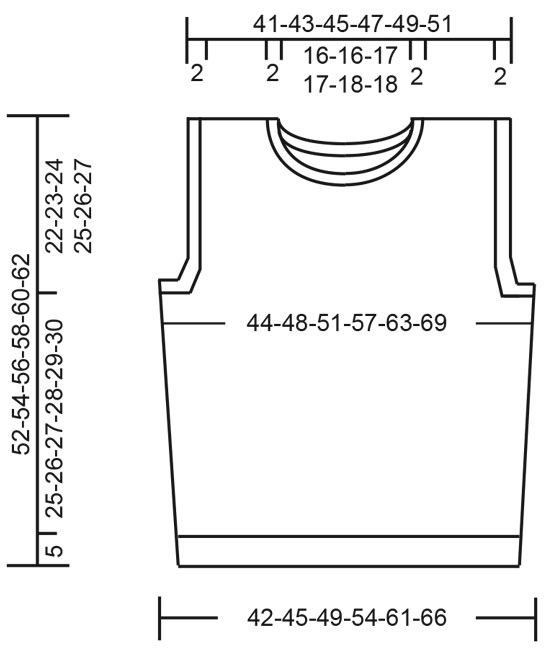
|
|||||||||||||
Have you finished this pattern?Tag your pictures with #dropspattern #backtoschoolvest or submit them to the #dropsfan gallery. Do you need help with this pattern?You'll find 26 tutorial videos, a Comments/Questions area and more by visiting the pattern on garnstudio.com. © 1982-2025 DROPS Design A/S. We reserve all rights. This document, including all its sub-sections, has copyrights. Read more about what you can do with our patterns at the bottom of each pattern on our site. |
|||||||||||||







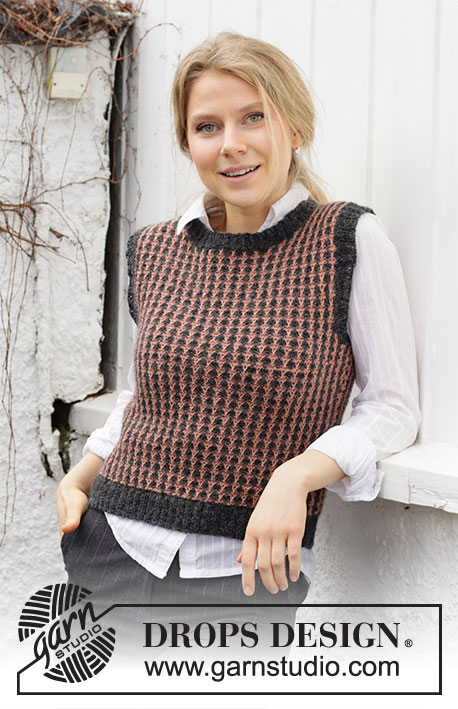

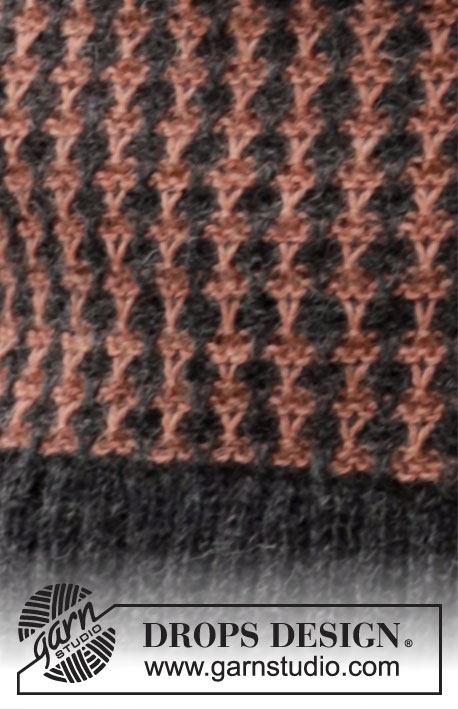

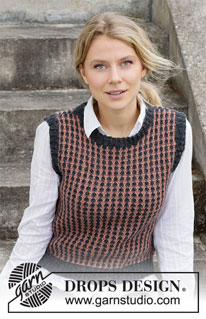
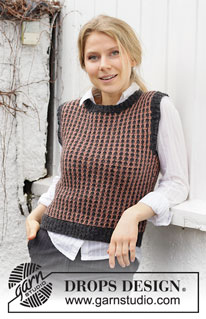
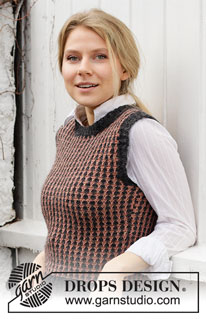
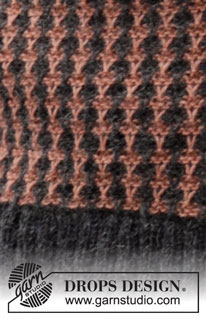































































Post a comment to pattern DROPS 218-22
We would love to hear what you have to say about this pattern!
If you want to leave a question, please make sure you select the correct category in the form below, to speed up the answering process. Required fields are marked *.